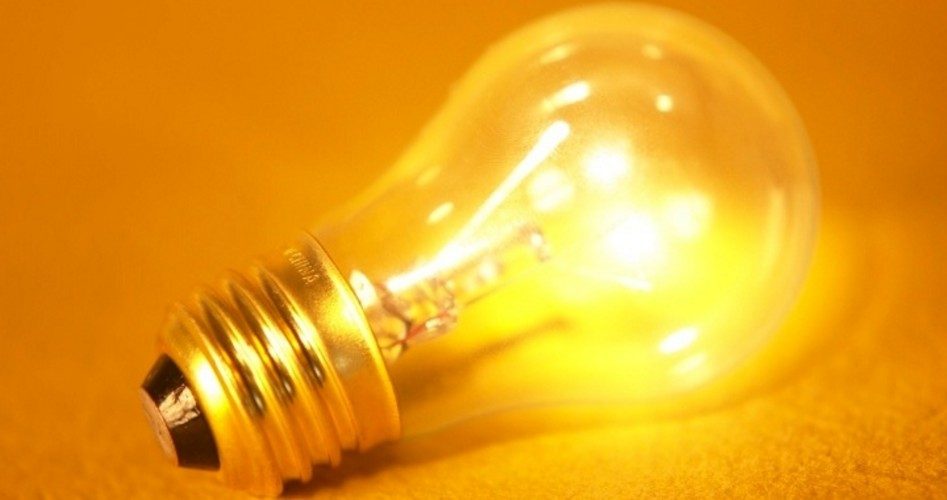
Amidst celebrations welcoming the New Year, commentators were also announcing the death of the ubiquitous light bulb — the incandescent variety — that Congress, in a fit of environmental overreach, banned in stages with legislation passed in 2007. For instance, Shawn Regan, writing at Reason magazine, called it “Lights Out for America’s Favorite Light Bulb,” while CNN wrote an obituary for it, adding that it was “the dawn of a new day,” without Edison’s invention.
Some even went so far as to claim the “ban” as a classroom example of crony capitalism, with light bulb manufacturers, distressed over the tiny profit margins in their 60-, 75- and 100-watt bulbs, cozying up to environmentalists to pressure Congress into giving them special treatment. Said Regan, “The ban is crony capitalism in its most seductive form — when it’s disguised as green.”
The New York Times noted that the huge Dutch conglomerate Royal Phillips Electronics, maker of high-efficiency (and high-profit) light-emitting-diode (LED) lights, had formed a coalition with a number of environmental groups including the Natural Resources Defense Council (NRDC) to press Congress to raise energy efficiency requirements on light bulbs to the point where incandescents would essentially be outlawed. The head of Phillips’ “strategic sustainability initiatives,” Harry Verhaar, said at the time, “We felt that we needed to make a call and show that the best-known lighting technology, the incandescent light bulb, is at the end of its lifetime.”
Edison’s invention has become a virtual commodity, with miniscule profit margins, and efforts to educate citizens about the wonders of the new LED and CFL (compact fluorescent lights — the ones with the curly tops) had essentially failed to wean them off the cheaper ones. According to the New York Times of June 5, 2011,
Phillips told its environmental allies that it was well-positioned to capitalize on the transition to new technologies and wanted to get ahead of an efficiency movement that was gaining momentum abroad and in states like California.
All that was needed was a little legislative assistance to push things along. Nothing drastic, just enough federal incentive that would require all light bulbs to become between 25 and 30 percent more efficient by 2013. That would neatly remove the incandescent bulbs from the market, leaving consumers with fewer but more expensive options to be supplied, naturally, by the big three makers: Phillips, GE, and Sylvania.
They had tried to persuade consumers the regular way, through marketing, advertising, and education. But those consumers just couldn’t, or wouldn’t, do the math. They didn’t care that most of the electricity used to fire up a light bulb is dissipated as heat loss. They didn’t care that they lasted only between 750 and 2,000 hours before they burned out. The Verge did the math: A 60-watt bulb costing around $2 will burn $7.23 of electricity in a year, and will last a little over a year, based on three hours a day of usage. A LED bulb, while costing $13, burns just $1.57 of electricity in a year, and it lasts more than five years. Think of the savings!
But consumers are deaf. Of the four billion sockets estimated in the United States, three-fourths of them are still filled with incandescent bulbs.
Part of the problem is the loopholes in the 2007 law. Sold as “an act to move the United States toward greater energy independence and security … [and] to increase the efficiency of products [such as light bulbs],” and promoted by House Speaker Nancy Pelosi as a way of lowering energy costs to consumers, it was riddled with loopholes. The law didn’t apply to appliance light bulbs, “rough service” bulbs, colored Christmas tree lights, plant lights, 3-way lights, stage lighting, candelabra lights, outdoor post lights, nightlights, or any bulbs of less than 40 watts or more than 100.
That leaves an awful lot of room for the free market to develop low-cost, high-efficiency options to the LEDs and CFLs offered by Phillips, GE, and Sylvania. For instance, Advanced Lighting Technologies has introduced a light bulb that Edison would recognize and envy, called the 2X Bulb, which greatly exceeds the 2007 law’s efficiency requirements while costing only slightly more than the ones currently disappearing from store shelves.
In an ironic twist, the prices of LED bulbs are falling so quickly that even CFLs are in jeopardy and may disappear from the market in the next few years. Spokesmen for GE and for Cree LED both admitted privately that CFLs are losing market share and not gaining as expected, and that manufacturers might just stop making them altogether.
At present there are plenty of the old-fashioned, low-cost bulbs around in any wattage a consumer could want. They are available on Ebay for under a dollar, and at 1000Bulbs.com, where common wattages are available at $.80 apiece, or even less in quantity.
Despite efforts of cronies such as GE, Phillips, and Sylvania to override consumer preferences through joint ventures with green groups bringing pressure on Congress, the free market is always at least one step ahead of the consumers’ needs. While useful as a classroom example of crony capitalism, these efforts of conglomerates are overshadowed once again by entrepreneurs operating in the private market economy bringing better answers at lower prices to consumers who know what they want.
A graduate of Cornell University and a former investment advisor, Bob is a regular contributor to The New American magazine and blogs frequently at www.LightFromTheRight.com, primarily on economics and politics. He can be reached at [email protected]



